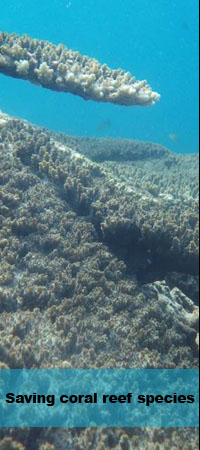|
For us it is already a busy year! We are conducting wildlife training to local communities, assessing and gathering data to protect coral reefs, conducting patrols and research to stop the killing of wild gorillas and other endangered species, restoring and protecting rainforest, apprehending illegal loggers, and surveying and protecting land for threatened species hand in hand with indigenous people.
These conservation fights are tough. They take time, money, expertise and passion. As many of you may know, despite facing obstacles such as malaria, extreme weather, interminable hikes and guerilla conflicts, we protect endangered species and wild habitats like no other groups. Extinction is forever. That's why our work is so critical right now and during 2013!
$0.98 cents of every dollar donated goes towards our field conservation efforts. Your donation is ensuring a sustainable future for imperiled species, and supporting the most effective projects in the field. Donate here!
ESI victory: tarsier sanctuary declared
Since the creation of the tarsier project in Mindanao Island, Philippines, ESI's main goal is to secure and expend safe habitat for the endangered Philippine tarsier. The tarsier is a very small primate threatened by habitat loss. After few years of hard work with local communities and government, ESI is proud to announce the declaration of the Philippine tarsier sanctuary by the Philippine government. The sanctuary is 504 hectares and home of other rare and endangered plants and animals.
No more rattlesnake roundup! Sign petition!
Each year thousands of rattlesnakes are removed from the wild and killed at "rattlesnake roundups." Rattlesnakes play a key role in the food web, maintaining balance in nature by preying on rodents, but hunting of snakes for roundups is pushing some species toward extinction. Sign petition here!
Typhoon Bopha decimating coral reefs exposed by ESI
When Typhoon Bopha, also known as Pablo, ran ashore on Mindanao, it was the largest tropical storm it ever hit the Philippine island. In its wake the massive superstorm left over 1,000 people were dead and 6.2 million affected with officials saying illegal logging and mining worsened the scale of the disaster. However, the Category 5 typhoon also left a trail of destruction that has been less reported: coral reef destruction. Read more here!
Trees and human health
Scientists with the U.S. Forest Service have observed a link between human health and trees, implying that trees may actually mitigate both cardiovascular and lower respiratory disease. study looked at 1,296 counties in 15 states across 18 years to discover that the absence of trees may actually increase mortality rates from certain diseases. Comparing communities that had lost their trees to emerald ash borer—a beetle that has killed over 100 million trees in the U.S.—with other communities that still had tree-lined streets, the study found that communities without trees suffered an addition 15,000 deaths from cardiovascular disease and 6,000 deaths from lower respiratory disease. ESI has already planted thousands of endangered tropical trees to support rainforest conservation.
Bumblebees need more help
Bumblebees are among the most important plant pollinators, and they are the exclusive insect pollinator of greenhouse tomatoes. There are approximately 250 species of bumblebees (genus: Bombus) in the world. Yet, declines in range and abundance of many species have been documented, and the conservation status of many more species remains unknown. There is now a need to address and coordinate bumblebee conservation on a global scale to better save them and to create local projects favoring pollinators. ESI integrates pollinators when restoring wild habitats.
ESI supporting sharp emission of mercury and here is why:
Low levels of mercury can cause harm, and chronic exposure has unexpected and troubling effects on human and world's wildlife. Coal burning, gold mining, and other human activities release mercury into water bodies or the atmosphere, where it can travel great distances before settling back to Earth. It is well documented that wild animals are exposed to harmful levels of mercury. The last month’s international mercury emissions treaty is good first step. ESI supports sharp reduction of mercury.
Great illustrations for ESI protected area
Kate Whittington is currently completing an internship with Endangered Species International. She produced beautiful illustrations for a series of interpretive signs to be installed on a trail through the Mount Matutum Protected Landscape. Her illustrations depict endangered plants and animals and provide an important addition to the new protected sanctuary. The astounding work of Kate can be viewed here! Thank you Kate.

|









